Related Research Articles

The Morgan horse is one of the earliest horse breeds developed in the United States. Tracing back to the foundation sire Figure, later named Justin Morgan after his best-known owner, as well as mares of the now-extinct Narragansett Pacer breed, Morgans served many roles in 19th-century American history, being used as coach horses and for harness racing, as general riding animals, and as cavalry horses during the American Civil War on both sides of the conflict. Morgans have influenced other major American breeds, including the American Quarter Horse, the American Saddlebred, the Tennessee Walking Horse, and the Standardbred.

The American Saddlebred is a horse breed from the United States. This breed is referred to as the "Horse America Made". Descended from riding-type horses bred at the time of the American Revolution, the American Saddlebred includes the Narragansett Pacer, Canadian Pacer, Morgan and Thoroughbred among its ancestors. Developed into its modern type in Kentucky, it was once known as the "Kentucky Saddler" and used extensively as an officer's mount in the American Civil War. In 1891, a breed registry was formed in the United States. Throughout the 20th century, the breed's popularity continued to grow in the United States, and exports began to South Africa and Great Britain. Since the formation of the US registry, almost 250,000 American Saddlebreds have been registered and can now be found around the world, with separate breed registries established in Great Britain, Australia, continental Europe, and southern Africa.

The Tennessee Walking Horse or Tennessee Walker is a breed of gaited horse known for its unique four-beat running-walk and flashy movement. It was originally developed as a riding horse on farms and plantations in the American South. It is a popular riding horse due to its calm disposition, smooth gaits and sure-footedness. The Tennessee Walking Horse is often seen in the show ring, but is also popular as a pleasure and trail riding horse using both English and Western equipment. Tennessee Walkers are also seen in movies, television, and other entertainment.

The Narragansett Pacer was one of the first recorded horse breeds developed in the United States. It emerged in the 18th century (1700s), and was theorized to have been bred from a mix of English and Spanish breeds, although the exact cross is unknown. The Pacer was associated with, and bred in, the state of Rhode Island and the area of New England; as horse breeding shifted to Kentucky and Tennessee in the late 1700s, it became extinct by the 20th century.
The Rocky Mountain Horse is a horse breed developed in the state of Kentucky in the United States. Despite its name, it originated not in the Rocky Mountains, but instead in the Appalachian Mountains. A foundation stallion, brought from the western United States to eastern Kentucky around 1890, began the Rocky Mountain type in the late 19th century. In the mid-20th century, a stallion named Old Tobe, owned by a prominent breeder, was used to develop the modern type; today most Rocky Mountain Horses trace back to this stallion. In 1986, the Rocky Mountain Horse Association was formed and by 2005 has registered over 12,000 horses. The breed is known for its preferred "chocolate" coat color and flaxen mane and tail, the result of the relatively rare silver dapple gene acting on a black coat, seen in much of the population. It also exhibits a four-beat ambling gait known as the "single-foot". Originally developed as a multi-purpose riding, driving and light draft horse, today it is used mainly for trail riding and working cattle.

An ambling gait or amble is any of several four-beat intermediate horse gaits, all of which are faster than a walk but usually slower than a canter and always slower than a gallop. Horses that amble are sometimes referred to as "gaited", particularly in the United States. Ambling gaits are smoother for a rider than either the two-beat trot or pace and most can be sustained for relatively long periods, making them particularly desirable for trail riding and other tasks where a rider must spend long periods in the saddle. Historically, horses able to amble were highly desired for riding long distances on poor roads. Once roads improved and carriage travel became popular, their use declined in Europe but continued in popularity in the Americas, particularly in areas where plantation agriculture was practiced and the inspection of fields and crops necessitated long daily rides.
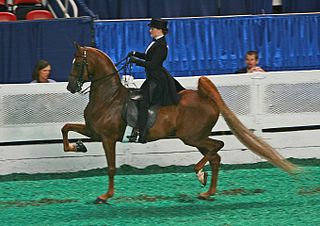
Saddle seat is a style of horse riding within the category of English riding that is designed to show off the high action of certain horse breeds. The style developed into its modern form in the United States, and is also seen in Canada and South Africa. To a much lesser extent, it is ridden with American horse breeds in Europe and Australia.
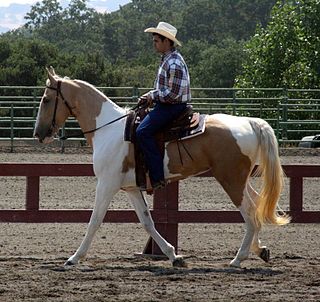
The Spotted Saddle Horse is a horse breed from the United States that was developed by crossing Spanish-American type gaited pinto ponies with gaited horse breeds, such as the Tennessee Walking Horse. The result was a colorful, smooth-gaited horse, used in the show ring and for pleasure and trail riding. Two registries have been created for the breed, one in 1979 and the other in 1985. The two have similar registration requirements, although one has an open stud book and the other is slightly more strict with regard to parentage requirements, having a semi-closed stud book. The Spotted Saddle Horse is a light riding horse, always pinto in color. Solid-colored foals from registered parents may be registered for identification purposes, so their pinto-colored foals have documented parentage. They always perform an ambling gait, rather than a trot, in addition to the gaits of walk and canter, performed by all breeds.
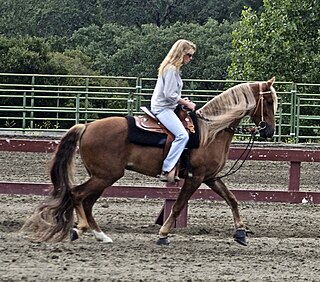
The Kentucky Mountain Saddle Horse is a horse breed from the U.S. state of Kentucky. Developed as an all-around farm and riding horse in eastern Kentucky, it is related to the Tennessee Walking Horse and other gaited breeds. In 1989 the Kentucky Mountain Saddle Horse Association (KMSHA) was formed, and in 2002, the subsidiary Spotted Mountain Horse Association (SMHA) was developed to register Kentucky Mountain Saddle Horses with excessive white markings and pinto patterns. Conformation standards are the same for the two groups of horses, with the main difference being the color requirements. The KMSHA studbook is now closed to horses from unregistered parents, although it cross-registers with several other registries, while the SMHA studbook remains open.
The Virginia Highlander is a small breed of horse with a four-beat ambling gait. It stands between 13 and 14 hands high. Coat colors include roan, chestnut, black and gray, and the occasional white. Breed characteristics include a good temperament and a natural singlefoot gait.

The Horse Protection Act of 1970 (HPA); is a United States federal law, under which the practice of soring is a crime punishable by both civil and criminal penalties, including fines and jail time. It is illegal to show a horse, enter it at a horse show, or to auction, sell, offer for sale, or transport a horse for any of these purposes if it has been sored.

Black Allan or Allan F-1 was the foundation sire of the Tennessee Walking Horse. He was out of a Morgan and Thoroughbred cross mare named Maggie Marshall, a descendant of Figure and the Thoroughbred racing stallion Messenger; and sired by Allandorf, a Standardbred stallion descended from Hambletonian 10, also of the Messenger line.
The North American Single-footing Horse, also called the Single-footing Horse or Single-footer, is a horse breed originating in the southern United States. The term "single-foot" refers to an intermediate ambling gait, sometimes alternately called the rack or paso largo, where the horse lifts each foot up separately and puts it down alone.

The Mountain Pleasure Horse is a breed of gaited horse that was developed in the Appalachian Mountains of Eastern Kentucky. This breed reflects the primitive Appalachian gaited horse type and genetic testing shows them to share ancestry with earlier breeds developed in the region, including the American Saddlebred, the Tennessee Walking Horse and the Rocky Mountain Horse. Some Mountain Pleasure Horse bloodlines are traceable for over 180 years.
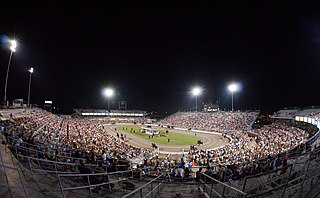
The Tennessee Walking Horse National Celebration (TWHNC), sometimes known as the Celebration, is the largest horse show for the Tennessee Walking Horse breed, and has been held annually in or near Shelbyville, Tennessee since its inception in 1939. The Celebration was conceived by Henry Davis, a horse trainer who along with several other horsemen, felt the Shelbyville area should have a festival or annual event. Although the Celebration was originally held in Wartrace, Tennessee, it moved to Shelbyville, the seat of Bedford County, a few years later. The Celebration spans 11 days and nights in late August and early September annually, and finishes with the crowning of the World Grand Champion Tennessee Walker on the Saturday night before Labor Day. The TWHNC draws an estimated 2,000 horses and 250,000 spectators to Shelbyville each year.
Denmark was a major foundation sire of the American Saddlebred horse breed. Over 60% of all the horses in the first three volumes of the Saddlebred studbook trace back to him. Denmark sired the stallion Gaines' Denmark, an influential sire of the breed.
The Racking Horse Breeders' Association of America (RHBAA) is the original registry for the Racking Horse breed. It was formed in 1971 in Decatur, Alabama and is still located there.
Bourbon King was an American Saddlebred stallion. He was known for being the founding sire of the popular Chief family of Saddlebreds.

The horse industry in Tennessee is the 6th largest in the United States, and over 3 million acres of Tennessee farmland are used for horse-related activities. The most popular breed in the state is the Tennessee Walking Horse - developed by crossing Thoroughbred, Morgan, Saddlebred, and Standardbred horses in the 19th and 20th centuries - and it became an official state symbol in 2000.
Redd Crabtree (1935-2015) was an American Saddlebred horse trainer. Crabtree, the son of notable Saddlebred trainers and saddle seat riding teachers Helen and Charles Crabtree, who owned Crabtree Stables, won three Five-Gaited World's Grand Championships and multiple World's Championships in the World's Championship Horse Show. He was president of the United Professional Horsemens Association, vice president and a director of the American Saddlebred Horse Association and was inducted into three Halls of Fame. Redd Crabtree died on January 19, 2015.
References
- ↑ "Ocala Star-Banner - Google News Archive Search".
- 1 2 3 "Official State Horse: Racking Horse". Alabama Department of Archives and History. Retrieved 2013-03-24.
- ↑ Fran Lynghaug. "The Official Horse Breeds Standard Guide: The Complete Guide to the Standards of all North American Equine Breed Associations" . Retrieved September 30, 2015.
- 1 2 3 4 5 6 Dutson, Judith (2005). Storey's Illustrated Guide to 96 Horse Breeds of North America. Storey Publishing. pp. 212–213. ISBN 1580176135.
- 1 2 "Section 5.2: Conformation" (PDF). Bylaws of the Racking Horse Breeders Association of America. Racking Horse Breeders Association of America. pp. 20–21. Retrieved 2015-08-27.
- ↑ "Racking Horse" . Retrieved September 28, 2015.
- 1 2 "Racking Horse".
- 1 2 Harris, Moira C. and Langrish, Bob; Bob Langrish; Moira C. Harris (2006-09-01). America's Horses: A Celebration of the Horse Breeds Born in the U.S.A. Globe Pequot. p. 171. ISBN 1-59228-893-6.
{{cite book}}: CS1 maint: multiple names: authors list (link) - 1 2 3 "Is the horse racking, or is it walking?".
- ↑ Racking Horse [ dead link ]
- ↑ "Single-Footing Horse | the Trail Rider". Archived from the original on 2015-12-29. Retrieved 2016-01-14.
- ↑ "Speck".
- ↑ "Registration".
- ↑ "Spokane Daily Chronicle - Google News Archive Search".
- ↑ "History". rackinghorse.org. Retrieved 27 September 2015.
- ↑ "The Horse Protection Act" (PDF). Animal and Plant Health Inspection Service. September 2009. Retrieved 2013-03-24.
- ↑ "RHBAA-HIO – Racking Horse Breeders Association of America".
- ↑ "Racking Horse World Celebration".
- 1 2 Pavia, Audrey; Posnikoff, Janice (16 March 2011). Horses for Dummies. John Wiley & Sons. ISBN 9781118054659.